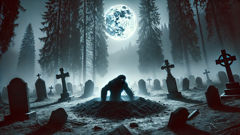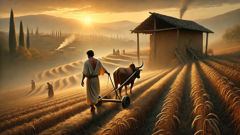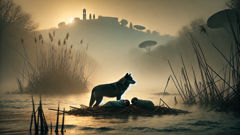Introduction
Beneath the serrated line of the Carpathians, where rivers run cold and the winter wind knows the names of the dead, a kind of fear takes root in the soil. It grows not from storms or wolves but from the memory of men who could not be forgiven in life. Villagers speak of them in low voices, making room for silence between sentences as if the sound might travel through earth and bone and stir a restless thing. They call such revenants pricolici: not mere beasts but the angry, uncompromising return of violent men who rise from their graves with the hunger of a grievance that time cannot heal. The pricolici is older than many laws written by kings; it belongs to the older law of the woods and the stones. It takes form in shadow and fur, in the crack of a branch under a hoof, and in the way a moonlit path seems to lengthen and wait. People in the valley learn the names of their neighbors and the stories of their deaths, because knowing a man's life is the first defense against his unquiet afterlife. The church says certain rites, the old women plant charms, and hunters lay iron traps, but the pricolici obeys older rules—rules braided from violence, dishonor, and the stubborn refusal of a soul to lie down. This is a tale of one such soul, and of a village whose quiet turned to a slow, deliberate terror by nights when the moon bled white and the dogs would not stop howling. It is a story about grief that becomes monstrous, about villages that remember, and about the fragile, merciless ways the living answer the wrongs of the dead.
The Bones of Folklore: Origins, Signs, and Superstitions
The pricolici, as villagers would explain when the wine warmed them and the candle sputtered, is a precise thing: it is a soul with an accusation. Where other stories let men change form willingly or by some curse passed in blood, the pricolici rises as the direct consequence of a life lived in cruelty or violation. In the scattered parishes of southern Transylvania and the Carpathian foothills, they say a man who murdered, abused, or broke sacred custom without repentance might return hardened by anger, an embodiment of the violence he once practiced. The distinction from the better-known strigoi or vampire is subtle and regional but important. A strigoi is a restless dead person who may rise through envy, improper burial, or failure of rites; a pricolici is specifically tied to the kind of earthly brutality that cannot be buried with simple prayers. The villagers' words are precise because survival depends on them.
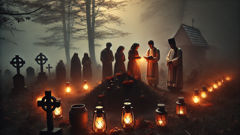
In the markets and at the wells, old women could read the signs a child could not. Dogs that would not let a gate close, chickens piling in one corner of the yard, the sudden decay of stored meat—all were small, early indictments. A pricolici did not announce itself with a flourish; it left a trace of wrongness in the angles of things. People learned to watch the sky when a certain pale clarity rose over the hills. The moonlight would find the pricolici’s favorite places, and something in its light seemed to sharpen the edges of grief and memory. Hunters spoke of the smell first: iron and old smoke under a new rain, a smell like a closed room left to sit for years. Then came sound: a low, human sound folded under a creature's baying; the crack of branches that sounded like someone’s joints.
Praxis—the practical knowledge of how to live alongside this terror—grew like a second language. Old rituals mixed with Christian rites in ways that made sense on the ground but puzzled scholars. To avoid creating a pricolici, families would ensure the dying were tended, that no soul left in wrath. Midwives and wise women prepared herbs and said prayers, and the priest might be called to perform a last absolution. If someone was suspected of becoming or already was one, the community moved with grim precision. Exhumation could be required: a body dug up with hands wrapped in cloth, the spine inspected for knots or unnatural angles. Hearth smoke and iron were trusted, but so were words and memory; a chronicler who spent time in these villages noted that names were powerful. To speak the true name of the dead, to tell the story of his misdeeds publicly, was to hold him to the measure of his life; not speaking was to allow a lie to fester in the dark.
One story repeated in dozens of houses tells of Ioan the Miller, a man whose hands had once broken a neighbor’s arm in a fight over grain. For years he prospered and the neighbor bore the injury in silence, but houses keep score in ways coin cannot show. When Ioan fell ill and died in a cold spring, his neighbors whispered and left elderberry branches at the corners of his grave. Within a fortnight of his burial the dogs went silent, the goats huddled, and a woman walking for water spoke of a shadow at the edge of the wheat. A child vanished and returned two nights later with teeth marks on her shoulder and the look of someone who had seen a thing she could not name. The villagers dug up Ioan. The body was found bent, the lips drawn back so his teeth seemed to catch at his own jaw. They staked him, burned his lodging, and turned a plow over his grave. For a time, the valley was still. But legends do not end neatly. Some say that a pricolici is not wholly destroyed by fire or stake unless the community’s memory is satisfied; otherwise, the grievance reasserts itself and a new seed of violence waits in the roots.
It matters, too, who tends the rites. In one hamlet, a priest named Petru insisted on strict burial according to the Church, rejecting charms and folk herbs as superstition. The elder women responded by leaving a wreath of garlic and rowan by the grave in secret. When the pricolici came, it turned its face away from the iron and the priest’s cross but recoiled from the scent of rowan and the sound of a particular lullaby the old women hummed. These are the small, localized truths of a living folklore: both priest and midwife hold part of the answer, and often what saves a village is their uneasy cooperation. Alongside such rites, practical measures are taken: full graves with stones placed over them, nails driven through the coffin lid, and gates barred at night. No one trusts a single remedy; the pricolici, like the weather, demands many defenses.
Landscape itself participates in the belief. Old boundary stones and yew trees mark places where the living and the dead meet regularly. On certain nights the wind seems to carry voices, and the river will rearrange pebbles as if answering an unspoken question. The pricolici uses these places as thresholds. Hunters would leave offerings—salt, bread, sometimes coins—at the threshold stones, not as bribes but as acknowledgement. To the villagers, ignoring a boundary is to invite a grievance; to make small amends, to name wrongs and right them where possible, is to keep the world in its place.
Language encodes warning. Mothers teach children a verse meant to ward off the unquiet: a short stanza that lists a man's misdeeds and a command to lie still. It sounds hardly poetic, more like a ledger read aloud: 'He took, he broke, he lied, he fled; lie still, lie still, trouble's not fed.' The formal church prayers lack that ledger, but the prayers of the hearth are precise and everyday. In the final analysis, the pricolici is not simply a monster to be slain but an ethics made monstrous: if a community refuses to speak honestly about wrongs, the wrong makes a home in the soil.
Not every accusation of pricolici proves true. There are night noises explained by foxes, stray dogs, and human cruelty masked as superstition. Witch-hunts and blood feuds have been excused by stories of revenants, causing real harm to those already vulnerable. This ambiguity is central to the legend's power: it warns against both the violence of the past and the violence of panic in the present. A village that jumps at shadows might end up committing the very cruelty that makes the soil bitter. The villagers know this, and the ritualized procedures—public confession, honest burial, communal watch—are meant as both remedy and moral corrective. The pricolici, then, binds the living together around truth or rips them apart with suspicion.
These beliefs shaped daily life. Farmers watched the moon and tended their fences. Choirs in chapels sang laments that were half prayer, half census. Hunters learned to recognize not just tracks but the absence of certain small signs—the way air moves where a living creature has passed, the faint pattern of crushed grass that speaks of a hurried stride rather than a human footfall. Sometimes the pricolici took the form of a wolf, sometimes of a malformed man; sometimes it moved on all fours with an animal’s grace and sometimes it stood and mimicked human gestures to lure the careless. But always it was an embodied accusation: a living answer to a life that refused to be forgiven.
In the next chapter of this valley's story, the pricolici's hunger becomes not only a private horror but a public crisis. A child is taken, a herd is slaughtered, and the village council must decide whether to follow law, folklore, or revenge. The choices they make reveal the fragile ethics by which rural communities hold themselves together, and they set the stage for a hunt that will test not only their courage but their capacity for honesty. The reader learns then that to face the pricolici is to face a ledger of wrongs, and that the sharpest weapon is often not iron but memory told aloud.
Hunt, Reckoning, and the Possibility of Redemption
When the pricolici began to press the village—when dogs ceased barking at the stables and the air tasted like old iron—things hardened into plan. A council was held beneath the roof of the town hall, which was, in winter, little more than a place to hang cloaks and speak until the cold made words thin. On the council sat the mayor, an old hunter named Dragos, the midwife Ana, the priest Petru, and a young woman named Alina whose brother had been taken in the night. Each had a role in the old choreography of such meetings. The priest sought a path of confession and absolution. The hunter wanted traps and fire. The midwife wanted examination and careful, secret remedies. Alina wanted an answer that read like justice—someone to blame and a way to close the wound.
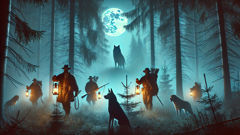
Their debate revealed the deeper bone of the problem. If the pricolici was a person risen from resentment, then taking out a single creature might still leave the cause untouched. If the village hid the truth about its own violent acts, then the soil stayed bitter and prone to sprout more grievance. The mayor, practical and brittle with age, suggested exhumation and a decisive destruction. Dragos wanted the pride of his guns, but the midwife reminded them that pride alone did not stop a revenant. They voted reluctantly: exhumation would happen at dawn, and everyone who had a memory of wrongdoing would speak it aloud before the priest's altar.
The exhumation turned the whole valley into a theater of watchful grief. Men who had once been neighbors now paced and avoided one another’s eyes. The body was what any corpse might be—damp with earth, the clothes stiff and dark—but there were anomalies: the hands were clenched as if holding something, and the jaw was thrown back as if gulping at a phantom prey. They found, upon cutting the bindings, small knuckle marks in the wrist bones, as if the fingers had sewn themselves closed in torment. The villagers took this as a sign that the dead had left no room for mercy. They staked the wood they had prepared, and Ana set her face to the work of cleansing garments and scattering rowan. Then the council demanded confession.
One by one, framed by the priest's candlelight, people confessed to wrongs seared more by regret than the present moment. A man admitted stealing a sharecropper’s wares during a famine; another confessed to striking a wife too harshly and then refusing to hear apologies; a youth admitted setting a dog on a traveling gypsy to hide his own fear of shame. Their names and deeds were read aloud, and the repeated telling was not a ritual cruelty but an attempt at truth. When the ledger of local sins lay open, the feeling in the hall changed from fear to a brittle, aching hope. It is not that confession undid the pricolici, but the act of naming altered the moral landscape. The belief was that the dead cannot be appeased by lies; they require acknowledgment.
That night, a hunt was organized. Dragos led a handful of men into the wood with lanterns and hounds. Alina followed at a cautious distance, swaddled in a cloak lined with herbs Ana recommended. The moon was generous and flat, spreading its pale cloth across the ground. Forest sounds were magnified and strange: branches tuning themselves like strings, the breath of animals, a distant, stuttering owl. The pricolici moved differently than any wolf. It stalked the edge of light and shadow, using trees as a screen and imitating human silhouettes to draw hunters where it wished. Dragos's hounds bayed and then fell silent, bodies flattened by an authority that did not belong to the forest. The first encounter was quick and obscene—teeth and a human groan—and Dragos came back with a strip of pelage and a handful of soil clinging to his boots. The hunters circled, unsure whether they had routed the creature or merely glimpsed an aspect of it.
That ambiguity is poisonous in a community on edge. A man’s certainty can become the law of the day, and when law becomes an ad hoc sword, harm follows. One young hunter, Numai, shot at what he thought was the pricolici and instead pierced the arm of a neighbor who had been following the same tracks. The neighbor died later from infection, and blame shifted like a stone. This allowed an important, grim truth to serve itself: panic often breeds the very violence it fears. The village watched itself unravel, and Alina began to understand that her brother's disappearance was not a simple theft of flesh but a symptom of a community that had a ledger unbalanced by silence.
When the hunters finally found the pricolici in a clearing ringed with old stones, it did not attack with mad savagery. Instead it moved with the deliberateness of someone who had both anger and memory. It shoved a hunter aside and pinned a goat, then stepped back and looked at them as a man might look at a jury. Dragos raised his spear. The pricolici slipped through the spear like a memory through a thin mind, leaving wounds that would not sew simply shut. Alina, seeing the creature pause as though listening to her aloud confessions repeated earlier by the priest, stepped forward. She held out a small mirror—an old charm that the midwife had taught her to carry. The pricolici recoiled from its reflected face. It was as if the mirror showed a man who had been more than his worst hours; the creature flinched at the complexity of itself.
Animals, the elders say, have no law but appetite; humans have memory and law and are crafty because of it. The mirror did not kill the pricolici. But it unsettled it long enough for Dragos to drive a stake into the beast’s heart-like center, and then for the others to apply a torch. They burned what remained. The fire did not purify everything. In the weeks after, the valley kept a silence that read like grief. Alina found her brother’s boots by the river, folded as if someone had meant to take them home. No one recovered the child who had vanished, and some nights when the moon was thin there were new sounds in the distance—short, human cries folded into the wind.
Justice, the elders reminded them, was not only about killing a creature or wasting a body. It was cultural and slow. They held councils where restitution was demanded: fields re-sown, a dowry paid, a public apology given in the square and recorded on the margin of the parish register. The village built a small stone memorial for those the pricolici had taken and those they themselves had hurt in fear. For generations, people came to lay thin sprigs of rowan on the memorial on the solstice or the anniversary of a death. The rituals changed; their function did not. They were a communal contract to remember and to repair when possible.
Not all endings the valley offered were tidy or redemptive. Some pricolici returned to haunt other slopes; some families carried the shame of a wrongly killed neighbor for a lifetime. Yet hope persisted in the form of ordinary, stubborn acts: someone teaching a child to read so the child might see other worlds, a midwife delivering a child and whispering the ledger in its ear so it would carry truth forward, a priest quietly burying the small things the church could not name. These were ways to make a place where grief might be absorbed and remade into a softer thing.
The deeper lesson of the hunt is this: monsters in the soil are made by the living's failure to tell truth. The pricolici is not only a creature of fang and fur; it is a measure of a community's refusal to address its wrongs. To stop one is to change how a village remembers its dead. To kill one and say nothing, to let shame fester in silence, is to seed another. In the valleys where the pricolici were feared longest, people learned a practical and moral economy: they tended both farms and stories with equal vigilance. In doing so they kept the ledger balanced, if never perfectly cleared.
Modern readers might hear the pricolici as mere superstition, relic of an age when people read signs into the landscape because they had no other instruments. But belief is not only about truth; it is about the tasks a community gives itself to perform: tending, confessing, repairing. The pricolici tests those tasks. It insists that you name what was done and decide what you will do now. The hunt becomes not purely violent spectacle but a renewed practice of care, however battered and imperfect, that keeps the world from folding into old anger.
Conclusion
The pricolici lives best, perhaps, in the spaces where we refuse to look. It is a legend braided from the tangible things of rural life—bad debts, broken oaths, anger wrapped in flesh—and from the rituals people create to keep their world whole. In valleys where winter lasts and the moon is a polished coin, communities learned to answer violence not only with iron but with story. They spoke their wrongs aloud and tried to place stones over them that would let the earth settle. Sometimes it worked: grief turned to memory, vengeance to law, and the pricolici became only a whisper in a child's bedtime rhyme. Other times, silence fed the dark until a new creature rose, furious at being forgotten. The pricolici legend asks an old question in a new voice: what do we owe each other when one of us errs? The answer is not tidy. It calls for confession, repair, and a stubborn practice of naming truth. In that stubbornness—humble, repetitive, communal—lies the possibility of laying certain monsters to rest and of keeping the light on for those who walk home late beneath a careless moon.

